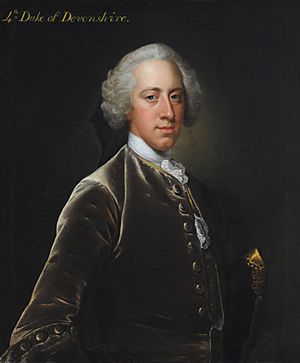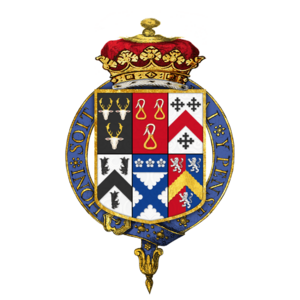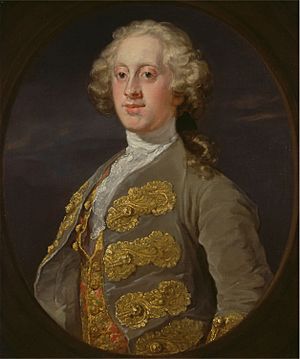William Cavendish, 4th Duke of Devonshire facts for kids
Quick facts for kids
The Duke of Devonshire
|
|
|---|---|

Portrait by Thomas Hudson, c. 1750s
|
|
| Prime Minister of Great Britain | |
| In office 16 November 1756 – 29 June 1757 |
|
| Monarch | George II |
| Preceded by | The Duke of Newcastle |
| Succeeded by | The Duke of Newcastle |
| Personal details | |
| Born | 8 May 1720 St Martin's-in-the-Fields, London |
| Died | 2 October 1764 (aged 44) Spa, Austrian Netherlands |
| Resting place | Derby Cathedral |
| Political party | Whig |
| Spouse |
Charlotte Boyle, 6th Baroness Clifford
(m. 1748; died 1754) |
| Children | William Cavendish, 5th Duke of Devonshire Dorothy Bentinck, Duchess of Portland Lord Richard Cavendish George Cavendish, 1st Earl of Burlington |
| Parents | William Cavendish, 3rd Duke of Devonshire Catherine Hoskins |
| Signature | |
William Cavendish, 4th Duke of Devonshire (born May 8, 1720 – died October 2, 1764) was an important British politician and nobleman. He was a member of the Whig political party. For a short time, he served as the Prime Minister of Great Britain.
William Cavendish was the first son of William Cavendish, 3rd Duke of Devonshire. His mother was Catherine Hoskins. He is also a very distant grandfather of King Charles III.
Contents
Early Life and Education
William Cavendish was born on May 8, 1720. He was the oldest of four sons. He was baptized (given a Christian name) on June 1, 1720, in London.
He likely studied at home with a tutor. Later, in 1739-1740, he went on a "grand tour" of France and Italy. This was a common trip for young noblemen to complete their education.
Early Political Career: 1741–1756
William Cavendish became a Member of Parliament (MP) for Derbyshire in 1741 and again in 1747. He supported important politicians like Sir Robert Walpole and the Pelham brothers, Henry and Thomas.
One politician, Henry Pelham, said that William Cavendish was "our mainstay among the young ones." This meant he was a strong and reliable supporter among the younger politicians.
He was offered the job of governor to the Prince of Wales, who later became King George III. However, he turned down this offer.
In 1751, he became the Master of the Horse. This was an important role in the royal household. To take this job, he had to leave the House of Commons and join the House of Lords. He also became a member of the Privy Council, a group of advisors to the King.
From 1755 to 1757, he served as Lord Lieutenant of Ireland. This role meant he was the King's chief representative in Ireland.
In December 1755, his father passed away. William then became the 4th Duke of Devonshire.
Britain was fighting the Seven Years' War at this time. The war was not going well. The current Prime Minister, the Duke of Newcastle, resigned in October 1756. King George II then asked William Cavendish, the Duke of Devonshire, to form a new government. He agreed, but only for a short time, until the end of the parliamentary session. He felt it was his duty to help the King and the country win the war.
Prime Minister: 1756–1757
In November 1756, the Duke of Devonshire became the First Lord of the Treasury. This position is now known as the Prime Minister. He also received the Order of the Garter, a high honor.
He served as Prime Minister until May 1757. During this time, William Pitt was a very powerful figure in the government. The government managed to get more money for the war. They also sent more troops to America and passed a new law called the Militia Act.
His government eventually ended for several reasons. One reason was that King George II did not fully support it. After his time as Prime Minister, a new government was formed. This new government, led by the Duke of Newcastle and William Pitt, guided Britain to victory in the Seven Years' War.
Lord Chamberlain: 1757–1762
After his time as Prime Minister, the Duke of Devonshire became Lord Chamberlain in the new government. This was another important role in the royal household. He worked closely with the Duke of Newcastle.
In October 1760, King George II died. His grandson, George III, became the new king. King George III was suspicious of the Duke of Devonshire and the Duke of Newcastle.
When the Duke of Newcastle resigned in May 1762, the Duke of Devonshire said he would not often attend meetings with the new leader, Lord Bute.
In October, King George III asked him to attend a meeting about peace terms. The Duke of Devonshire refused, saying he did not know enough about the topic.
A few days later, the King removed the Duke of Devonshire's name from the list of Privy Councillors. This was a very unusual and harsh action by the King.
Later Years: 1762–1764
The Duke of Devonshire resigned from his role as Lord Lieutenant of Derbyshire. He did this to show support for his friends, the Duke of Newcastle and Lord Rockingham, who had also been removed from their positions.
He had health problems for a long time. His health got worse in his final years. He traveled to Spa, a town in what is now Belgium, to try and improve his health. Sadly, he died there.
His death was a big loss for his political allies, especially the Whig leaders. He died at the age of 44, making him the shortest-lived British Prime Minister. He was buried at Derby Cathedral.
Family Life
In 1748, William Cavendish married Lady Charlotte Elizabeth Boyle. She was the daughter of a famous architect and art collector.
Through Charlotte, the Devonshire family gained many important properties. These included Chiswick House and Burlington House in London, and Lismore Castle in Ireland.
The Duke also hired famous designers for his main home, Chatsworth House. He had Capability Brown design the gardens and park. He also hired James Paine to design a new stable building.
The Duke and Duchess had four children:
- William Cavendish, 5th Duke of Devonshire (1748–1811)
- Lady Dorothy Cavendish (1750–1794). She married William Cavendish-Bentinck, 3rd Duke of Portland, who also became Prime Minister.
- Lord Richard Cavendish (1752–1781)
- George Augustus Henry Cavendish (1754–1834). He became the first Earl of Burlington.
Legacy and Impact
Historian Horace Walpole described the Duke of Devonshire as someone who was "always in a hurry to do nothing." This meant he seemed busy but sometimes struggled to make decisions.
Another historian, Paul Langford, said that the Duke of Devonshire was "eminently sensible and highly respected." His death left a big gap among the leaders of the "Old Whig" political group.
See also
 In Spanish: William Cavendish (1720-1764) para niños
In Spanish: William Cavendish (1720-1764) para niños



